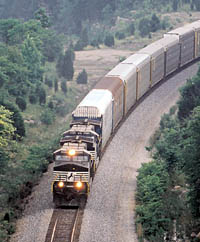
13 November 2006
Driving Down Auto Damage
 Equipment and service issues persist, but railroads and their
automotive customers have racked up impressive wins in damage control. They're now tackling a tiedown problem.
Equipment and service issues persist, but railroads and their
automotive customers have racked up impressive wins in damage control. They're now tackling a tiedown problem.
Seven of every 10 motor vehicles that move to market in the United States move by rail. It's a capital intensive,
high-risk business, and protecting this pricey cargo in transit has long been a railroad priority.
The biggest step in this direction was the creation over a number of years of a fleet of fully enclosed multilevel railcars. About
54,000 of these now operate in a nationwide Reload fleet. They are basically bilevel and trilevel racks purchased by the railroads
from Trinity Industries and mounted on 80-foot flatcars leased from TTX, which manages the pool. There's agitation among
some automotive shippers for a new "universal" motor vehicle railcar, but the existing Reload fleet, with its embedded
investment and the high utilization made possible by the flexibility of fully compatible cars, is likely to be around for a while.
This does not mean that new-design cars won't be added. Waiting in the wings or already on stage are FreightCar America's
lightweight, rust-resistant Aluminum Vehicle Carrier (AVC), of which CN has acquired 200, CPR 375, and Amtrak 80 for its
Auto-Train Service. There's also Trinity Industries' Uni-Level for hauling trucks, minivans, and other large
vehicles that now move to market under their own power and in the process accumulate mileage that detracts from their sale price.
After three years of successful testing, co-developer Norfolk Southern plans to order 200 Uni-Levels through
TTX next year. Also, there are increasing signs that, one way or another, the industry is going to find a bigger place in its system
for Greenbrier Companies' super-sized, articulated Auto-Max, which is now used almost entirely in dedicated
service for Honda. The automaker is so pleased with the service that last month it began taking delivery of 400 of its own
Auto-Max II models, built by Greenbrier at its plant in Sahagun, Mexico. Meanwhile, keeping the current autorack fleet in
shape is keeping available repair shops busy.
The more elderly of these cars are sometimes referred to as "old dogs." Teaching them new tricks isn't always easy, but it's
not impossible. Modifying the entire fleet for a smoother, safer ride is an ongoing process. and it is here that the railroads have
launched heir latest initiative in damage control.
"We've made steady progress in reducing L&D," says David Julian, President - Automotive & Supply Chain Services,
Norfolk Southern, who also serves as chairman of the industry's Multilevel Pool Executive Committee. "The damage measurement used
by the automotive industry is the ratio of claims to vehicles shipped. Back in the early '90s, that ratio was 3% to 4%. After the
railroads spent $350 million to equip the entire fleet of rackcars with premium trucks and preloaded draft gears, there was a big
reduction in the ratio of claims, to around 1%. Today the ratio of damage claims to vehicles shipped has fallen below
one-half of 1% on an industry-wide basis, and on Norfolk Southern our damage claims ratio with Toyota and
General Motors is close to two-tenths of 1%."
|